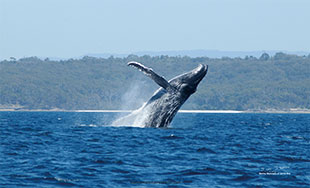
Dolphin and whale watching

Whales and dolphins are common sights in the marine park.
- Humpback whales migrate north to their winter breeding grounds off Queensland in June/July.
- They return south again to feed in the cold waters of the Antarctic from September to November. They often enter Jervis Bay's calm water to rest with their young. Easily spot breaching whales from local headlands and beaches.
- Endangered Southern right whales also shelter in the safety of the bay during northward migration.
- Other species recorded in the region are the minke, fin and sei whales, and on one occasion a blue whale. Travelling orcas, or killer whales, have occasionally been spotted in the bay and further offshore.
- About 60 Indo-pacific bottlenose dolphins call Jervis Bay home. They can often be seen from shore, travelling in small groups, feeding and socializing along the way. Offshore, look out for pods of hundreds of common dolphins feeding on schools of baitfish.
- Most visitors choose to observe marine mammals from one of the commercial boats that run dolphin watching cruises year round and whale watch tours seasonally.
- Visit the NSW Environment, Energy and Science and Wild About Whales for more information about whales.
- Visit Shoalhaven Tourism for more visitor information including charter operators.
The park has several Australian and New Zealand fur seal haul-out sites, which are believed to be the northern-most haul-out sites on the east coast.
- Steamers Head in the park's south is home to about 120 seals at the season's peak.
- A new colony established at Drum and Drum Sticks in recent years has more than 100 animals.
Marine mammal encounters
If you are going out for a viewing in your own vessel, or watercraft (surfboards, paddle boards, kayaks etc), see the National Parks and Wildlife guidelines at the NSW Environment, Energy and Science . The guidelines detail how and when to approach whales and dolphins and how close you can get.

